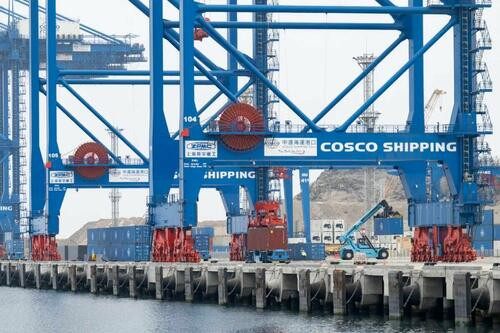China Envisions ‘Dry Canal’ To Compete With Panama Canal
Authored by James Gorrie via The Epoch Times (emphasis ours),
In response to the Trump administration’s new U.S. policy of reasserting control over the Panama Canal, China and Brazil are exploring the possibility of building a transcontinental railway to provide an advantageous alternative to the Panama Canal. The proposed rail system would potentially run from Brazil’s Atlantic coast, perhaps Ilhéus, Bahia, to Peru’s Pacific coast at Chancay.

The project, known as the Central Bi-Oceanic Railway Corridor (CRBC), has been in consideration since at least 2017. Other proposed projects of a similar nature and objectives have been considered since at least 2013. There are other terms applied to the transoceanic railway project, but essentially, the system would cut across the Amazon rainforest and go over—and likely tunnel through—the Andes mountain range, linking Atlantic and Pacific port facilities.
Many Obstacles and Risks to Overcome
Of course, there’s often a wide gap between planning a project and actually doing it successfully. There are certainly formidable obstacles that would have to be overcome for the project to move forward to completion. The geographic and topographic challenges are considerable. Clearing a path through the Amazon rainforest or tunneling through the Andes mountains aren’t easy engineering feats.
There would also be legal challenges over land rights and environmental resistance to the project and against the development of the necessary supporting infrastructure along the way. The initial costs incurred by each country would also be a significant challenge, as would be establishing a sustainable debt service and maintaining the political will to stick to the plan when these and other obstacles arise.
The Trade Advantages Would Be Significant
Although it would be a complex, multi-year project with significant costs and engineering challenges, there would also be several advantages in doing so. For one, proponents estimate that it would cut shipping time to Asia by 10 to 12 days. With shipping costs rising and economies struggling, those factors aren’t easily ignored.

But it’s not just a railway system that would be built. The system will be a key addition to the deep-water port that China is building in Chancay, Peru, on the Pacific Ocean. Deep-water ports enable the largest cargo ships and container vessels to dock and transfer their goods quickly and easily, without the complications of moving through various locks and channels that come with relying on the passage through a very crowded and slow Panama Canal transit.
A similar deep-water port would be constructed on Brazil’s Atlantic coast, with both ports providing a much smoother and more economical way to move goods around the world.
Much More Than Just a Railroad
Chinese planners envision the CRBC as a comprehensive project that serves the entire trade and transportation cycle. This “dual-track” logistics corridor—combining port infrastructure, rail links, logistics hubs, and industrial zones to permit transit from Pacific to Atlantic (or vice versa)—could well prove to reimagine and redirect global and regional trade flows.
It would also reduce the canal’s chokepoint dependencies and potential vulnerabilities. Compared to all of the benefits the proposed railway, the Panama Canal would become seen as more burdensome—not less—to global trade, rendering it a less-desirable, more costly and time-consuming option.
The transformative potential of the CRBC project cannot be overstated. It would be a continuation of China’s role as a major player in ports, dams, energy, and other infrastructure in the region.
Gaining Strategic Regional Leverage While Avoiding US Control
From China’s perspective, the proposed transcontinental rail system is a way to minimize or even eliminate U.S. dominance of interoceanic trading in the region. The proposed overland route would significantly reduce Beijing’s vulnerability to U.S. control, blockades, and trade leverage over canal access.
That alone is a compelling reason to pursue the project.
But developing an economically superior alternative to the Panama Canal also gives Beijing more leverage and influence over their Latin American trading partners. That influence would largely come at the expense of U.S. influence, thereby diminishing American power in the region. It would also add proof of concept and gravitas to China’s Global South initiative and help expand the BRICS currency influence and use in the Americas.
All of these factors would give China added leverage over its Latin American partners. Those countries helping to build and host parts of the railway system will certainly gain strategic importance. At the same time, their dependency on Chinese capital, products, and technical assistance would expand, allowing Beijing to embed itself into those regional governments and economies more deeply.
Furthermore, the development of deep-water ports in both Brazil and Peru will give the Chinese regime safe havens to park its rapidly expanding navy, and the pretext to establish and maintain a large and adversarial naval warship presence in America’s backyard. A regional threat on such a scale would have been unthinkable even a few years ago. It could reasonably be compared to the re-colonization of the region.
A Multidimensional, Long-Term Impact
Beijing’s plans for the CRBC are as expansive as they are threatening to U.S. regional hegemony and beyond. The resulting impact of the CRBC would be transformational in a multidimensional context, and for the long term. Beijing would reasonably be able to shape trade terms, shipping standards, customs operations, and logistics norms in the region, and much of the rest of the world.
If Beijing succeeds in its CBRC plans, it could elevate the blighted Belt and Road Initiative up to a new level and lift China to the pinnacle of global power. The United States, on the other hand, would find itself out-hustled, out-traded, out-funded, and out-gunned by China in the Americas.
Let’s hope that the United States has plans to preempt or prevent China’s big move in America’s backyard.
Views expressed in this article are opinions of the author and do not necessarily reflect the views of The Epoch Times or ZeroHedge.
Tyler Durden
Fri, 10/24/2025 – 22:35ZeroHedge NewsRead More





 T1
T1


